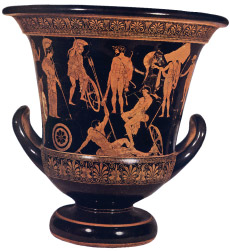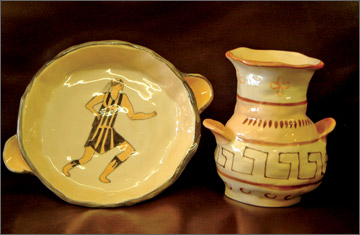Going to pot
By Shireen SENADHIRA
Once, there was a little pond where kingfishers sat brooding on
overhanging branches of trees. It was in a plantation in the Gampaha
district where we holidayed as children. To go to this pond quite a
distance away from the bungalow, was an adventure in itself for us
children because we met all the characters from the stories we were told
in the evenings.
 The pond was interesting because it had a bottom layer of light grey
clay and the blue waters over it were crystal clear and sizzling cool.
Lovely waters there, where one never wanted to stop bathing and the
children spent hours watching little fish swim silhouetted against the
bottom background of light grey. The pond was interesting because it had a bottom layer of light grey
clay and the blue waters over it were crystal clear and sizzling cool.
Lovely waters there, where one never wanted to stop bathing and the
children spent hours watching little fish swim silhouetted against the
bottom background of light grey.
A daring cousin however, jumped into this not so deep pond and
brought out a mass of clay. From then on, the holiday was busy with
moulding the clay into figures and animals. My brother made a hippo from
the clay and we thought it was a large dog. He was angry with us but
worse it was, when later the dried hippo was knocked down and it went to
pieces.
Another time later, elsewhere, when the children were running in and
out of the house someone banged on a cupboard and the large jug on top,
shook. However, someone else was quick and saved the falling jug. Then
as we looked at the saved jug, we saw it had long clothed figures
depicting some actions of daily life. What happened then? A know all
cousin came up and warned us about dire consequences of breaking
valuable jugs and added that it was a Greek urn.
She said that the famous poet John Keats wrote an ode to the Greek
Urn. We were subdued into silence, she seemed satisfied with our unease
and placed the jug inside the cupboard and left. Then, there was an
indignant outburst. “If Keats was such a great poet why did he write
about a silly old jug? “ “Pooh! An inanimate object. Was he confined to
an earthenware store and never been outside? “ “I guess Sylvia just
wanted to sound superior!” With the last announcement we drifted away to
the garden. Many years later, most of us thought of this incident and
chuckled when we studied English literature and poetry.
Ancient Grecian urns
 Ancient Grecian urns were commonly illustrated with scenes and
subjects of the area where the urn was created. It also depicted the
time and style of the place. Very ancient urns featured paintings of war
and heroic deeds. The one Keats had in mind probably came from the
free-style period. In this era, urns were characterised by scenes of
religious and musical ceremonies. Due to the subject matter, Keats’s
Grecian urn has been dated to be prior to 4thcentury BC. Ancient Grecian urns were commonly illustrated with scenes and
subjects of the area where the urn was created. It also depicted the
time and style of the place. Very ancient urns featured paintings of war
and heroic deeds. The one Keats had in mind probably came from the
free-style period. In this era, urns were characterised by scenes of
religious and musical ceremonies. Due to the subject matter, Keats’s
Grecian urn has been dated to be prior to 4thcentury BC.
In the poem, the main feature that captures the readers is about the
figures that are frozen in time. They depict that they are in the middle
of an action and remain thus for eternity. The ardent lover will never
kiss the girl he pursues but then she will never age either. The painted
boughs are full of leaves and the piper will be piping while the
ceremonial procession moves on. These claims are of course true in the
imaginary sense. Note must be taken that John Keats was central in the
Romantic Literary movement. John Keats penultimate line in the poem, Ode
on a Grecian Urn is “Beauty is truth, truth beauty,” a much discussed
sentence and it is keeping with Keats’s view towards higher truth
through art. It could portray that art takes its truth from life and
then returns it to life as beauty.
Lyrical expression
A point of interest is that as Greek vases moved art lovers to
lyrical expressions of delight, one Grecian urn moved John Keats to
write the above famed lines of beauty and truth. In the next century
these vases aroused the instinct of collectors. The late William
Randolph Hearst began buying Grecian vases in 1901 and owned 400 of them
when he died fifty years later.
What’s in a pot anyway? Actually, Greek pots are important because
they tell us so much about how life was in Athens and other ancient
Greek cities. Pots came in all shapes and sizes depending on their
purpose and were often beautifully decorated with scenes of daily life.
Most often, these scenes depicted what the pot was used for. Greek did
believe that the goddess Athena invented the potter’s wheel.
Pottery is believed to have begun in the period 29000 BC to 25000 BC.
During the Neolithic period, the lifestyle of the areas in the Middle
East and Africa was transitioning from the nomadic hunters and gatherers
to farmers and baskets were needed to gather the crop produce but these
couldn’t hold water. As water was essential in growing of crops, perhaps
necessity helped in finding a material, inexpensive, light and pliable
to be made into carriers of water and liquid.
Clay fitted the bill and it was found in abundance in the regions.
Early pots were built by stacking rings of clay, later to be smoothened
out dried and fired under a bonfire. Prior to this, a hole would have
been made in a lump of clay, then, the bowl that was formed would have
been dried and fired. The feasibility of such would have brought about
the making of pots. Pots made in these early times were undecorated and
expendable. They were made as a means for transportation of liquids.
Potter's wheel
It is believed that the potter’s wheel arrived on the scene in
Mesopotamia about 3000 BC. At the beginning of the Bronze Age, potters
were using the slow wheel which was a movable platform enabling them to
rotate the pot and mould it rather than walk round the pot to work on
it. By 2000 BC the potter’s wheel had evolved into a fast wheel which
enabled the potters to draw out the pot out of a lump of clay through
the spinning motion. The invention of the fast wheel was a big technical
breakthrough for the potters. Very many centuries later it developed
into the motorised potter’s wheel with electricity. During the time of
the fast wheel, the Indo Europeans migrating into Greece, Italy and
China took with them this new potter’s wheel. Long ago in Ancient
Egyptian mythology, it is said that the deity Khnum had formed the first
humans on a potter’s wheel.
It was the Greek craftsmen who made pottery an art form. Their pots
and vases were for drinking and pouring, as well as storing wine, olive
oil and water. They were the first to experiment with adding colour by
combining clay with other naturally occurring ingredients such as ochre
and potash.
These craftsmen decorated their vessels with characters of Greek
mythology. In Athens black and red figure pottery was termed fine
pottery.
The white, undecorated and simple pottery ware fulfilled household
purposes. Vase painters applied a slip, which is clay in more liquid
form to vases and this slip turned black during firing.
 When red figure motifs on cases remained the colour of clay and the
background filled with slip turned black after firing, the contrast was
striking and artistically attractive. When red figure motifs on cases remained the colour of clay and the
background filled with slip turned black after firing, the contrast was
striking and artistically attractive.
This type of traditional Greek Vases continue to be made up to the
present. Such vases are easily snapped up when put up for sale.
At the beginning itself of pottery making, people used the craft to
show their social identity. It was a way of showing how different they
were from other societies. Thus it can be seen that Greek pottery is
different from Egyptian pottery and Chinese pottery.
Indus Valley civilisation
The Indus Valley civilisation was a Bronze Age civilization
(3300-1300BC). This was one of the earliest civilizations and had its
contemporaries of Mesopotamia and Ancient Egypt. At its peak the Indus
valley people developed new techniques in metallurgy and handicraft
including pottery. This civilization is noted for its cities built of
brick, multistoried houses and a drainage system too. The Mohenjodaro
and Harappa civilizations arose about 2500 BC in the Indus Valley and
ended with destruction about 1500BC. In the Harappan culture, the
Harappan pottery was sturdy and well baked and mostly plain but a
substantial part of it was treated with red slip and black painted
decoration.
It is interesting to note that decorations consisted of horizontal
lines of varying size, leaf patterns, chequers, latticework, palm and
peepal trees. Animal, bird and fish too were also painted. The pottery
was of pedestal, dishes, goblets, cylindrical vessels and variety of
bowls. Their pottery was glazed, polychrome, incised, perforated and
knobbed. Many centuries later, the excavations of the Indus valley
sites, which are even going on today, have brought forth a profusion of
pottery some of it adorned with animal and geometrical motifs.
Breakthrough
A big breakthrough came about in 600AD during the Han Dynasty in
China when their potters began to make porcelain (porr-se-lenn) cups and
pitchers. These delicate and artful pieces, known as fine china, were
created from white kaolin clay combined with ground granite and fired at
high temperatures.
Transportation of such pottery was expensive and therefore potters in
West Asia invented lead glaze to mimic the porcelain look. This type of
glaze was decorative too. European potters followed suit creating
colourful glazes to use in their pottery. Through the centuries it is
seen that pottery has continued to evolve both as a craft and an art.
Even in 1200AD the Chinese pottery was the best and the most expensive.
Therefore, West Asia potters imitated the Chinese designs and Europeans
used coloured glazes to imitate the West Asian designs.
Pottery in Sri Lanka
Pottery in Sri Lanka is one of the oldest handicrafts and has a long
unbroken tradition. It dates back to the 5th century BC. The potter as
an artisan, creating both utilitarian and decorative items has carved a
niche for himself in the social structure of the country. During the
time of the Sinhalese Kings they were presented with acres of highland
and tracts of Paddy in return for their services to the king and his
court.
Archaeological findings in different parts of the country however,
have shown different types of pottery. These finding prove there was
wide use of pottery even before the period of recorded history. Since
there was no paucity of raw materials, the tradition of pottery craft
continued without interruption. Though there was a threat from the
aluminum utensils industry in recent times but the family based pottery
industry has managed to overcome this due to its environment producing a
relaxed and peaceful scenario for working.
Just imagine taking a newly moulded clay pot and smoothing the base
of it with a wooden spatula in a village with the kiln fire burning
nearby in a heartwarming way. All this going on with a gentle breeze
wafting through the surrounding shady trees and the air filled with
birdsong. The ambience is enough for a person to break into a song or
spill out some long drawn kavi.
Simplicity
The primarily utilitarian character of Sri Lanka pottery has been
continuing since the very beginning of Aryan Sinhalese civilization of
Sri Lanka. The simplicity of ornamentation and charm of the elegance of
pottery have held fast in the island for more than a couple of
millenniums and a half in Sri Lanka. Low fired cooking pots, jugs,
bowls, goblets, tiles and cases are the most widely used kitchen
utensils of the country. In addition to these, intricately designed
products such as terra cotta figures, carved vases, ornaments such as
figurines and delightful animals with distinctly the country
characteristics are also produced at pottery workshops. I remember the
Kelaniya and Devundara festivals that had large displays of pottery ware
and the stylized horses were a delight. So were the coloured little clay
pots that aided children with many a game of cooking on a proper fire
known as sellam bath. The little oil lamps of clay which are produced in
abundance light up many a scene and many a heart during festivals and
rituals
Uses
The many uses of pottery pieces today can be seen everywhere. They
range from our dinner table to the bottom of space shuttles. Next time
at the table dining off beautiful Sri Lankan porcelain, remember that
from a tiny bit of the good earth the potter had turned out these lovely
things of beauty to be treasured.
The usefulness of this item is so immense that, whether man made,
machine made or nature made it has been and will be around for a long
time. It is in display in most places wherever you look, be it in
bricks, floor tiles, indoor tiles, ornaments or utility vessels.
Very many artists still work only with these materials making
beautiful works of art with nothing but their hands, a little water and
an imagination that hopefully will never run dry. |

